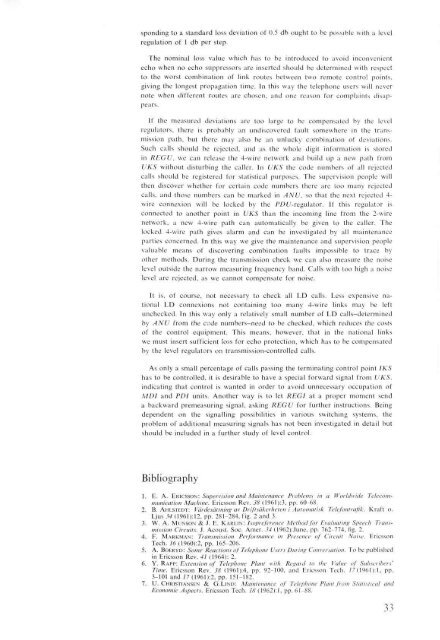1 - History of Ericsson - History of Ericsson
1 - History of Ericsson - History of Ericsson
1 - History of Ericsson - History of Ericsson
You also want an ePaper? Increase the reach of your titles
YUMPU automatically turns print PDFs into web optimized ePapers that Google loves.
sponding to a standard loss deviation <strong>of</strong> 0.5 db ought to be possible with a level<br />
regulation <strong>of</strong> 1 db per step.<br />
The nominal loss value which has to be introduced to avoid inconvenient<br />
echo when no echo suppressors are inserted should be determined with respect<br />
to the worst combination <strong>of</strong> link routes between two remote control points,<br />
giving the longest propagation time. In this way the telephone users will never<br />
note when different routes are chosen, and one reason for complaints disappears.<br />
If the measured deviations are too large to be compensated by the level<br />
regulators, there is probably an undiscovered fault somewhere in the transmission<br />
path, but there may also be an unlucky combination <strong>of</strong> deviations.<br />
Such calls should be rejected, and as the whole digit information is stored<br />
in REGU, we can release the 4-wire network and build up a new path from<br />
UKS without disturbing the caller. In UKS the code numbers <strong>of</strong> all rejected<br />
calls should be registered for statistical purposes. The supervision people will<br />
then discover whether for certain code numbers there are too many rejected<br />
calls, and those numbers can be marked in ANU, so that the next rejected 4wire<br />
connexion will be locked by the PDt/-regulator. If this regulator is<br />
connected to another point in UKS than the incoming line from the 2-wire<br />
network, a new 4-wire path can automatically be given to the caller. The<br />
locked 4-wire path gives alarm and can be investigated by all maintenance<br />
parties concerned. In this way we give the maintenance and supervision people<br />
valuable means <strong>of</strong> discovering combination faults impossible to trace by<br />
other methods. During the transmission check we can also measure the noise<br />
level outside the narrow measuring frequency band. Calls with too high a noise<br />
level are rejected, as we cannot compensate for noise.<br />
It is, <strong>of</strong> course, not necessary to check all LD calls. Less expensive national<br />
LD connexions not containing too many 4-wire links may be left<br />
unchecked. In this way only a relatively small number <strong>of</strong> LD calls-determined<br />
by ANU from the code numbers-need to be checked, which reduces the costs<br />
<strong>of</strong> the control equipment. This means, however, that in the national links<br />
we must insert sufficient loss for echo protection, which has to be compensated<br />
by the level regulators on transmission-controlled calls.<br />
As only a small percentage <strong>of</strong> calls passing the terminating control point IKS<br />
has to be controlled, it is desirable to have a special forward signal from UKS.<br />
indicating that control is wanted in order to avoid unnecessary occupation <strong>of</strong><br />
MDl and PDl units. Another way is to let REGI at a proper moment send<br />
a backward premeasuring signal, asking REGU for further instructions. Being<br />
dependent on the signalling possibilities in various switching systems, the<br />
problem <strong>of</strong> additional measuring signals has not been investigated in detail but<br />
should be included in a further study <strong>of</strong> level control.<br />
Bibliography<br />
1. E. A. ERICSSON: Supervision and Maintenance Problems in a Worldwide Telecommunication<br />
Machine. <strong>Ericsson</strong> Rev. 38 (1961 ):3, pp. 60-68.<br />
2. B. AHLSTEDT: Vardesdttning av Driftsdkerheten i Automatisk Telefontrafik. Kraft o.<br />
Ljus 34 (1961):12, pp. 281-284, fig. 2 and 3.<br />
3. W. A. MUNSON & J. E. KARLIN: lsopreference Method for Evaluating Speech Transmission<br />
Circuits. J. Acoust. Soc. Amer. 34 (1962):June, pp. 762-774, fig. 2.<br />
4. F. MARKMAN: Transmission Performance in Presence <strong>of</strong> Circuit Noise. <strong>Ericsson</strong><br />
Tech. 16 (1960):2, pp. 165-206.<br />
5. A. BOERYD: Some Reactions <strong>of</strong> Telephone Users During Conversation. To be published<br />
in <strong>Ericsson</strong> Rev. 41 (1964): 2.<br />
6. Y. RAPP: Extension <strong>of</strong> Telephone Plant with Regard to the Value <strong>of</strong> Subscribers'<br />
Time. <strong>Ericsson</strong> Rev. 38 (1961):4, pp. 92-100, and <strong>Ericsson</strong> Tech. 77(1961):1, pp.<br />
3-101 and 17 (1961):2, pp. 151-182.<br />
7. U. CHRISTIANSEN & G.LIND: Maintenance <strong>of</strong> Telephone Plant from Statistical and<br />
Economic Aspects. <strong>Ericsson</strong> Tech. 18 (1962):1, pp. 61-88.<br />
33
















